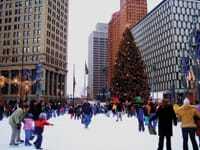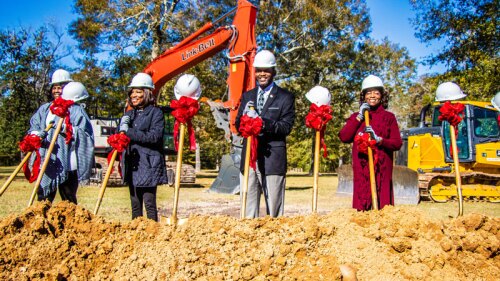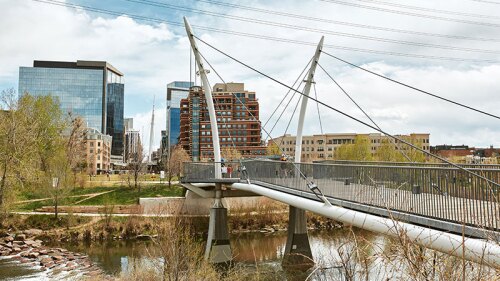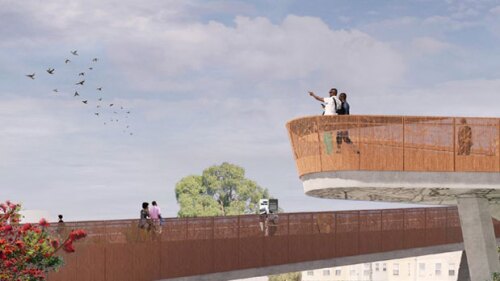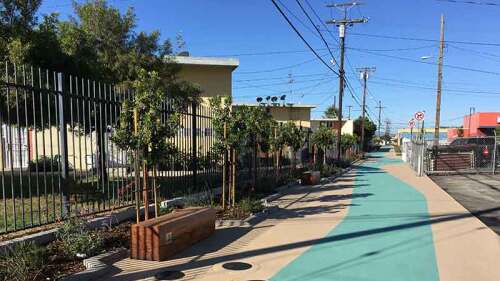Campus Martius recently was awarded the 2010 ULI Amanda Burden Urban Open Space Award after Detroiters and national observers alike have raved about Campus Martius since it opened in November 2004 at the city’s historic crossroads, a once-gritty intersection where five major streets converge. It is a 2.5-acre (1-ha) oasis of imaginative horticulture, green granite walls, crushed limestone paths, and gurgling water. But Campus Martius is more than a public park—it has become an economic engine for a struggling city.
Urban parks can be value generators. Of no small benefit to its struggling host city, Campus Martius has delivered a positive economic impact. Two major office buildings have risen adjacent to the site, and residential developments and restaurants have opened nearby. Experts estimate that $500 million of investment has flowed into the area since plans for the park were announced.
“The park played a major role in our move to Detroit,” says Peter Karmanos, Jr., founder and CEO of Compuware Corporation, a business software and services firm that built a $400 million, 16-story headquarters across from the park and became a major Campus Martius financial backer.
Last summer, Quicken Loans, an online mortgage company, moved 1,700 employees into the Compuware building from its headquarters in suburban Livonia, and an additional 500 Quicken employees moved to a nearby building. And GalaxE.Solutions, a New Jersey–based information technology firm, announced last April that it would spend $4.2 million to rehab part of a building on the park’s northwest corner and create 500 jobs over the next four years. Wrote John Gallagher of the Detroit Free Press, “Campus Martius is at the heart of Detroit’s development story.”
The park received national recognition in April when the Washington, D.C.–based Urban Land Institute chose it as the first-ever recipient of the ULI Amanda Burden Urban Open Space Award. Presenting the award, Burden, chair of the New York City Planning Commission and director of the New York Department of Planning, said Campus Martius “reflects a creative, innovative approach to transforming an eyesore into a jewel.” Dennis Archer, the former Detroit mayor who started planning for the park, says winning the award made years of work worthwhile. “For us to come out number one—that’s huge,” he says. “I really wanted something that would capture people’s imagination. And we got it.”
Urban parks can be a bellwether for a renaissance. The neighborhood around the park has been the center of town for centuries. In 1805, when Detroit—already 104 years old—began rebuilding after a fire destroyed the frontier community, leaders plotted the future metropolis from the so-called Point of Origin on land known as the Campus Martius (pronounced marsh-us), Latin for “the Field of Mars.” Detroit grew up around Campus Martius into a mid-century industrial powerhouse, but jobs and residents began leaving as suburbanization took hold and the automobile industry’s presence in the city began to shrink. The population has been halved in 60 years, and a survey conducted in 1996 found that 80 percent of the 67 buildings in the city center were empty, accounting for 6 million square feet (558,000 sq m) of unused space.
In the late 1990s, however, two important things happened: Detroit started preparing for its 300th anniversary in 2001, and Karmanos began talking about moving Compuware and its 3,500 employees downtown from a bland suburban Detroit office park. That represented a reversal from the usual trajectory of Detroit businesses fleeing the city, and it helped spark interest in the Campus Martius site.
A number of businesspeople and civic leaders formed a group known as Detroit 300 and eventually decided to develop the park as a legacy project, raising $20 million toward its construction.
Urban parks can return focus to a downtown. To develop a vision, Detroit 300 turned to the Project for Public Spaces (PPS), a New York City–based nonprofit organization that emphasizes a place-making process drawing on extensive consultations with a wide variety of local people rather than professional planners. PPS, Gregory, and a task force also examined successful urban spaces from New York City to London and came up with a list of 25 must-have features, including year-round activity, a water focus, a café, gardens, stages, and an emphasis on showing off the best of Detroit culture.
For designer, they selected Rundell Ernstberger Associates, a small Indiana-based firm. “We had every rock star in the design world bidding on this,” says Gregory. “Nobody had ever heard of them, but they showed the most flexibility by taking all these disparate elements and putting their own stamp on it.”
Water runs along wavy granite walls that border the west side of the park, and in the southeast corner, surrounding an elaborate 1872 Civil War monument, there is a smaller waterworks. The Point of Origin is marked by a medallion laid in granite and covered by a glass portal at the center of a compass emblazoned in concrete pavers. A wide variety of trees shelter the park, and lush lawns, divided by the fountain, are sunk slightly below street level, giving people sitting in chairs a sense of protection from the passing traffic.
Just like the movable chairs that allow park visitors to design their own coffee klatch, the park transforms itself on a bigger scale: stages rise from the ground at both ends of the north lawn, and with specially designed lighting and sound, the park becomes an open-air theater for concerts, films, and other events. When the weather starts turning cold in the fall, workers assemble the popular skating rink for winter; a plinth above the idle fountain serves as a setting for a large Christmas tree or other movable focal elements. The year-round programming lends the park the urbanity that bolsters its charm, park officials say.



